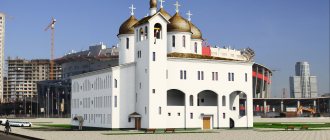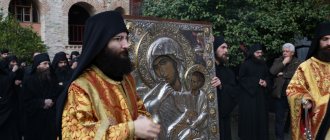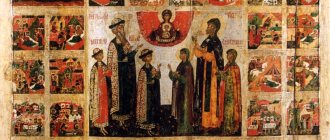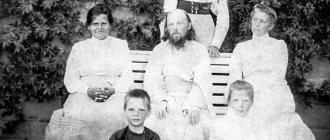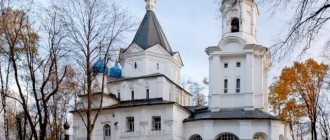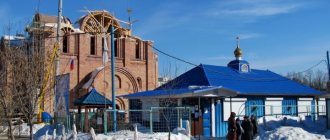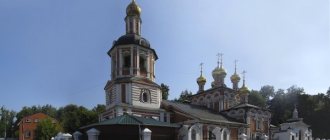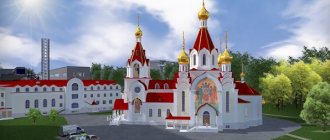Temple of Otrada and Consolation on Khodynka Field today
This cultural and spiritual Orthodox center is located in Moscow at 16 Polikarpova Street. It has several names: Temple of the Icon of the Mother of God “Consolation and Consolation” (or Otrad Church); it is also called the Vatopedi Church. People also find this name – “Cossack” temple on Khodynka. It is the Temple-Monument of Russian Sorrow.
Initially, it was created as a center of grief for Russian believers for those innocently killed. It was erected in honor of the Moscow Governor-General, Grand Duke Sergei Alexandrovich, who fell at the hands of the terrorist Kalyaev. The church was founded on a symbolic date - on the prince’s 50th birthday after a memorial service at his grave.
The Vatopedi Church received its name due to the fact that the Vatopedi Icon of the Mother of God had the long-standing name “Consolation and Consolation”, so the temple became a symbol of grief and consolation for those who lost their loved ones in the troubled years of the early twentieth century.
The church, once considered the most counter-revolutionary, has today become one of the centers of the spiritual life of believers and one of the most beloved cultural spaces in Moscow. Various religious events are often held at its base, where parishioners attend with pleasure.
The building is interesting for its architectural design. This is an example of the culture of the Russian people and a unique attraction of Moscow, which attracts the attention of many tourists. Today it is included in the list of the most majestic churches in Moscow “Forty Forties”.
Externally, the building looks rather squat and small, but in fact, about 500 believers can simultaneously reside within its walls.
Historical events
Temple "Otrada and Consolation" on the street. Kakhovka began to be built after a meeting on the location of an Orthodox church on the territory of the capital district in 2014. In February of this year, construction began on a temporary church, which is still in operation.
The temple received its name in honor of the icon of the Mother of God “Consolation and Consolation”, which is its main shrine:
- In March 2014, a memorial service for the innocent people killed in Ukraine was held for the first time in a temporary church, which was attended by more than 50 parishioners. A few days later, the first prayer service took place in front of the icon, which was attended by residents of the Zyuzino district.
- Opening of a church shop, now open daily from 12:00-17:00. On sale are candles, icons, literature on Orthodox themes, Easter souvenirs, as well as the opportunity to order prayer services and memorial services, and donate for the construction and decoration of the temple.
The consecration and installation of a dome with a cross on a temporary temple took place:
- In April 2014, a minor consecration of the temporary temple took place. The ceremony of consecration was led by His Grace Bishop Theophylact of Dmitrov. The church choir sang during the service. Many parishioners were present at the consecration. Immediately after the consecration, the first Liturgy took place, at which more than 20 parishioners began to take the chalice. The rector of the temple, Priest Alexander Melin, expressed his gratitude for the help in the construction of the temple, the labor incurred and support in his endeavors. He also called the construction of the temple an effective measure in response to destructive processes in the world, including those occurring on the territory of friendly Ukraine.
- In January 2015, the first divine liturgy on the Nativity of Christ took place.
- In March 2021, the Sunday school operating at the church passed certification.
Project of the Temple of Otrada and Consolation on Kakhovka
The project of the future temple was completed:
- In September 2021, the blessing of His Holiness the Patriarch was received for the construction of the temple.
- November 2021 – the project of the future temple was tested and received a positive expert opinion.
- August 2021 – the heating main was installed.
- In September 2021, the image of the Blessed Virgin Mary was consecrated.
- In October 2021, permission to build the temple was received and preparatory work for its construction was carried out.
- In December 2021, permission to carry out excavation work was received.
6 new icons were consecrated: St. ap. Andrew the First-Called, martyr. Demetrius of Thessaloniki, mts. Valentine, prophet Elijah, St. Anthony of Pechersk, St. blgvv. Knn. Peter and Fevronia:
- March 2021 – 4 new icons appeared in the temple: St. St. Alexei, Man of God, St. blgv. Book Daniel of Moscow and St. Spyridon of Trimifuntsky.
- May 2021 – 4 new icons appeared in the church: St. prpp. Elders of Optina, Holy Equal-to-the-Apostles Mary Magdalene, Holy Martyr Irina, Holy Martyr Galina.
- July 2021 – the icon of the Royal Stratobearers was consecrated.
- August 2021 – 2 new icons appeared in the temple: the Cathedral of the Archangel Michael and other Heavenly Powers and St. mts. Raisa.
- October 2021 – 6 new icons appeared in the temple: the blessed princess Anna Kashinskaya, “The Tsarina of All,” and “The Three-Handed One.” The last 2 icons were painted in Athos.
- November 2021 – 4 new icons appeared in the church: St. John of the Climacus, Holy Martyrs Gury, Samon and Aviv, Holy Martyr Bonifatius, Holy Great Martyr Marina, an icon of the Blessed Queen Tamara, the Mother of God, a small image of the Holy Royal Passion-Bearers.
- December 2021 – 3 new icons were consecrated for the temple under construction: the icon of the holy martyr Tryphon, the icon of the holy martyr Lyudmila and the icon of the holy 40 Martyrs of Sebaste.
- March 2021 – the icon of St. Paisius the Holy Mountain was illuminated. The beginning of the project to make bells for the belfry of the new temple.
Today, funds are being raised for the final 4th stage of the construction of the temple. The list of final works includes roofing, plumbing and heating to the temple, as well as casting and installation of domes. A contract has been signed for construction work, but the amount is quite large, so the Temple willingly accepts donations from parishioners.
The Temple accepts donations in a variety of ways.
- Purchasing a Certificate for a registered brick. To do this, contact the rector or purchase it at the church shop.
- Transfer to a Sberbank card indicating the transfer “For statutory activities.”
- Transfer of funds to the Yandex.Money payment system. To do this, transfer money from your own wallet, use a payment terminal, or use transfers from other bank cards.
Architect, exterior decoration, architectural ensemble
The Temple of Otrada and Consolation on Khodynka Field was designed by the architect V. Adamovich. The style in which the temple was built is called Byzantine; the author imitated Balkan churches. In its appearance and the number of vertical windows in the dome (there are 12 of them), the temple resembles the Church of the Twelve Apostles, built in Thessaloniki (Greece) at the beginning of the 14th century.
Church of the Twelve Apostles, Thessaloniki (Greece)
V. Adamovich visited Mount Athos several times, from where he came up with the idea of designing a temple in the style of early Byzantium, which differed from contemporary trends.
The main body is supported by 4 impressive supports (pylons) located on the sides, made of red and yellow bricks, on which small domes are located. The façade has striped masonry. This is also a feature of the Byzantine style.
In the western part of the building above the entrance there is a skillfully decorated belfry.
The preparation of the iconostasis, as well as the development of internal and external decor, was carried out by the architect V. Guryanov, an icon painter and restorer. The architect V. Mayat, V. Adamovich’s co-author in many architectural projects, was also involved in the work.
In the 2000s, the iconostasis of the temple was replenished with new works made in the workshop founded by T. Trubnikova.
Interior decoration
Since the construction of the temple is still not completed, the interior decoration is not yet available. Work to equip it will be carried out after completion of construction work.
According to the project for the construction of the temple, only the appearance of the structure is known - a single-domed building with a spherical belfry, a white building.
History of construction
The appearance of this church became possible thanks to the actual state councilor I. A. Kolesnikov, who did a lot for its construction. He petitioned Moscow Governor-General S. Gershelman to allow him to build this temple at his own expense.
The idea for the name also belongs to him. According to I. A. Kolesnikov, this center of religious life was supposed to help soldiers and Cossacks receive joy in prayer, and in difficult times of their lives - consolation.
The Temple of Otrada and Consolation on Khodynka Field was built over the course of 3 years, after which it was consecrated (April 5, 1909), which was conducted by Metropolitan Vladimir of Krutitsky and Kolomna. Princess Elizaveta Feodorovna was invited to the ceremony.
At the beginning of the 20th century, Khodynskoye Field was the location of the barracks for the Cossacks of the 4th Don Cossack Regiment and the first Grenadier Brigade. These units took the greatest part in suppressing the rebellion of 1905.
The temple built on this site became a symbol of Russian grief for the fallen Cossacks and soldiers who were faithful to the oath and suppressed popular unrest during the first Russian revolution.
He performed his immediate functions for 12 years, after which he had to endure a lot before he again became the center of spiritual life. 1922 became the year of the beginning of the struggle against the church for the whole country; during this period, church valuables were actively confiscated and churches were closed.
This fate befell the Vatopedi Church, which was soon destroyed: the belfry and all 5 domes were damaged. In some places, the brick fence, which was a continuation of the architectural design, was destroyed. The openings that formed in it were closed with heavy concrete slabs.
The building began to be used for the economic needs of the country.
At different times it housed:
- army club;
- workers' dormitory from mechanical engineering;
- a warehouse where hardware was stored;
- workshop of one of the construction factories.
The year 1980 became decisive in the fate of the temple. Local authorities took the initiative to build a parking lot in its place. This decision was made in connection with the planned reconstruction of the Botkin hospital, which was located near the church. The parking area was necessary for cars to access the morgue.
The chief physician of this hospital, I. Kuzin, showed concern for this situation. He appealed to the city authorities with a request to preserve the old church building and return it to its functions. This building was to become the first hospital church in the country.
The courage of such an act can be judged by those who remember this difficult time when atheism was part of communist ideology. As a result of barbaric actions, most churches were destroyed and their shrines were plundered.
Thanks to the courage of I. Kuzin, who then dared to declare the importance of preserving a spiritual shrine, Muscovites received a restored building, which began its second life and became an example of the architecture of religious buildings of the beginning of the last century.
The authorities partially granted the request of the chief physician - they did not destroy the temple building. But they were in no hurry to transfer it into the possession of the church - the influence of ideology was too strong.
However, 10 years later, during perestroika, when attitudes towards religion changed, it was decided to transfer this old building to the Russian Orthodox Church. In 1990, it became part of the All Saints Deanery District, which united all the churches in the Northern Administrative District of the capital.
The hospital staff supported their leader in his desire to revive the shrine, and the Patriarchate also joined in. As a result, it was decided to appoint the young abbot Irinarch, who was an employee of the Department of External Church Relations, as rector of the “Consolation and Consolation” church.
All production equipment that was located within the walls of the building was removed at the beginning of January 1991. At the same time, the consecration of the temple took place. January 5, 1991 became an important date for all Christian believers, since on this day the church was legally returned to them.
The Church of Otrada and Consolation on Khodynskoe Field was restored only 5 years later, in 1996. In addition to the participation of the Russian Orthodox Church, voluntary donations played a large role in the restoration of the church. Hegumen Irinarch (now Bishop of Krasnogorsk), the rector of this church from 1996 to 2002, contributed a large amount to this good cause.
Interior decoration
Inside, on the walls of the temple there are white marble boards on which are written the names of people related to the authorities, convicted and killed for political reasons during 1904 - 1907. throughout the country. The number of victims is 1850 people.
This martyrology amazes everyone who enters and shows what great proportions the communist terror reached, which flourished throughout the country at that difficult time.
The attention of everyone who comes to the temple is attracted by the iconostasis, trimmed with gold and having 2 tiers. The iconostasis was made of marble, it is decorated with fine carvings and gilding bordering the icons.
The stucco molding and columns of the building are made of material that imitates stone. The belfry, located on the western side of the temple, has 3 arches. The building has many columns and arches, which creates a feeling of open space, and the cornices are decorated with beautiful Byzantine-style patterns.
Shrines and relics of the temple
One of the shrines that believers strive to see is the Shroud. It was hand-embroidered by the nuns of the Novo-Alekseevsky Monastery, repeating the drawing of the famous artist V. Vasnetsov. The work used the skill of sewing with gold and silk threads.
The temple houses several more unique things:
- painting by V. Vasnetsov depicting the Last Supper;
- icons, the author of which is the painter and iconographer V. Guryanov;
- a list of the miraculous icon “Consolation and Consolation”, which was brought from Athos and dates back to the 10th century.
All these shrines were restored with great difficulty and returned to the temple in 2000. Most of the masonry of the walls was preserved in its original form and designed in the ancient Byzantine style.
And the bell towers and domes were completely restored. Since over time the sketches of the architect V. Adamovich were lost, the restorers took photographs of the temple from the early 20th century as a basis.
Clergy, mentors
Among all the existing clergy of this temple, Hieromonk Hierax (in the world I. Bocharov) enjoyed special respect. Representatives of Orthodoxy still argue a lot about his tragic fate, as well as about his personality.
In July 1927, the Declaration of Metropolitan Sergius of Stragorodsky was published, in which it was written about the importance of the church’s loyal attitude to Soviet power. Hieromonk Hierax, like many others, did not accept this message and was deprived of his parish.
In the 1930s, he conducted services clandestinely and, as punishment, in 1943 he was arrested and exiled to the Gulag. Who was behind this remains a mystery, because at that time the attitude of the authorities towards the church changed for the better. Church parishioners remember this man with great human warmth.
The service in the church is led by a rector (I. Kudryavtsev), 2 archpriests (S. Rozhdestvensky and D. Shumov), 2 priests and 2 deacons. The Church of “Consolation and Consolation” has an honorary rector. This is L. Pokrovsky - Metropolitan Kirill of Stavropol and Nevinnomyssk.
Interesting facts and legends
The exact origin of the original icon of the Mother of God “Consolation and Consolation” is not known, but there are 2 versions.
According to the first, in 395, the son of Emperor Theodosius, Arkady, was on a sea voyage and fell overboard, but the Most Holy Theotokos interceded for him and the prince survived. As a token of gratitude, the emperor donated the Vatopedi Monastery, and an icon of the Most Holy Theotokos appeared on its altar, which was given the name “Otrada”; later a second word was added to the name.
The word “Consolation” was added to the name after the events of 807, when during morning prayer the abbot heard a woman’s voice coming from the icon. The Mother of God warned him of the danger and ordered him not to open the gates of the monastery, from where the pirates were supposed to appear. She repeated these words three times and froze.
The abbot hastened to inform all the brethren about what he had heard, and everyone noticed that the expression on the Mother of God’s face had changed. They believed the words of the abbot and glorified God and the Mother of God, since they managed to repel the attack on the walls of the monastery. Afterwards the icon began to be called “Consolation and Consolation”.
According to the second version of the origin of the icon, its creation dates back to the 14th century. Then, at the moment when the abbot was handing over the keys to the gate to the gatekeeper next to the icon, the Mother of God turned to him and warned him about the attack on the monastery. After this miraculous appearance, the icon was decorated with gold and silver chasuble, and was also transferred to the choir of the cathedral, where it remains to this day.
In memory of the deliverance, prayers are sung to the Mother of God every day in the monastery. In memory of the icon, a holiday is celebrated on January 21 (according to the old style - February 3).
Parish and choir of the temple
The Temple of Otrada and Consolation is visited daily by several dozen adults and children, and on holidays many guests come here. A visit to the church on Khodynskoye Field is also included in the tourist program.
The church regularly hosts concerts of the chamber youth choir. The directors of the choir are Kirill Trukhachev and Seraphim Kudryavtsev. The folk choir of this church performs for parishioners on church holidays; sometimes religious chants are heard in the church, performed by the church folk choir and Sunday school students.
Here anyone can learn to sing in a choral studio under the guidance of professionals.
Sunday School
The church operates a Sunday school for children of different age groups:
- 5 – 6 years;
- 7 – 9 years;
- from 10 years.
Sunday school in the Temple of Otrada and Consolation on Khodynka Field
Classes are conducted according to a special program for Sunday schools “Vertograd”, developed on the basis of a textbook (author - Seraphim Slobodsky). It contains not only theological topics, but also information concerning the natural sciences and Russian culture.
In addition to working with textbooks, children perform practical tasks, draw, and make applications.
Contacts
You can get to the temple at st. Malaya Yushunskaya, 1, bldg. 1. The temple stands at the intersection of Kakhovka and Azovskaya streets in the Zyuzino district.
To contact us regarding questions of interest, you can choose any convenient type of contact.
| Contact | Data |
| Telephone | +7(963) 77 03 370 |
| Sunday School Director's Phone Number | +7(963) 68 42 570 (Zlata Pavlovna) |
| Website | otrada-nam.ru |
| [email protected], | |
| VKontakte | otrada_nam |
| Classmates | otrada.nam |
| otrada | |
| otradaiu |
Schedule of services, opening hours
The church doors are open to parishioners every day.
The schedule is usual for Orthodox churches:
| Day | Working hours |
| Monday Friday | 7.30 – 19.00 |
| Saturday | 7.30 – 19.30 |
| Sunday | 6.30 – 19.00 |
Divine Liturgy is held every Saturday, Sunday and on holidays (starts at 8.30). The evening service the day before begins at 17:00.
The schedule of services is regularly published on the temple website and updated monthly.
Interesting facts about the temple in the surrounding area
The Temple of Otrada and Consolation on Khodynskoe Field is an example of architecture and spiritual culture. This is the first and only temple considered a monument to the victory over the Russian Revolution in 1905.
Hospital named after S. Botkin
In the vicinity there is a clinical hospital named after. S. Botkin, blood center named after. O. Gavrilova, veterinary center. A little further is the Institute of Film and Television.
Famous clergy
The most significant figure for the Cossack Church is the former rector, Hieromonk Hierax (in the world Ivan Matveevich Bocharov). His life from childhood was connected with the Church, since the boy lost his parents early. Raised by the monks of the Voronezh Zadonsk monastery, he received an excellent spiritual and musical education. In 1915, the young man took monastic vows at the Trinity-Sergius Monastery, and three years later he received the rank of hierodeacon.
In 1919, Hierax became a hieromonk and went to serve the Moscow Church “Joy of All Who Sorrow” at the Lefortovo Military Hospital. Two years later he was transferred to the Cossack Church on Khodynskoye Field, where he spent almost 10 years.
After Metropolitan Sergius of Stragorodsky issued the “Declaration” on July 16, 1927, Bocharov stopped mentioning his name during church services, and soon went completely underground. Hiding from the Soviet authorities, he settled with his spiritual daughter, continuing to celebrate services in the house church.
As a comrade-in-arms of Bishop Afanasy (in the world Sergei Grigorievich Sakharov), on November 6, 1943, Ieraks was arrested for anti-Soviet propaganda. Together with him, Sakharov himself, Nina Trapani (Bocharov’s spiritual daughter), nun Susanna and Archpriest Pyotr Shipkov were taken into custody.
Until the 50s of the twentieth century, the persecuted hieromonk served exile in the Kemerovo region, and after his release he became a resident of the Mordovian home for the disabled. Towards the end of his life he moved to Vladimir, where he lived until 1959.
Information for pilgrims
You can find out how the temple works, what time the services are held, and who exactly conducts them by phone. The church has its own website where all the necessary information is posted.
The temple workers made sure that parishioners with low vision could be informed about the latest news related to the work of “Consolation and Consolation.” The site has a version for the visually impaired.
The temple has its own page on Instagram, and its parishioners actively communicate on the forum.
Where is it located, what is in the surrounding area, how to get there
The road to the temple in the name of the icon of the Mother of God “Consolation and Consolation” is not difficult to find. It is located at: Moscow, st. Polikarpova, 16. You can get here by metro to one of the stations: Dynamo, Begovaya or CSKA. From the station to the temple itself you still need to walk about 15 minutes.
The closest station to it is Begovaya station. It is convenient to come here by taxi, which will take passengers directly to the temple gates. Among other urban transport, buses, trolleybuses and minibuses go here. The stop is nearby, within walking distance.
Everyone who has ever visited the hospital named after S.P. Botkin, which is located very close to the temple, knows about this center of spiritual life.
In 2021, the Church of Otrada and Consolation acquired official status - Cossack. Every year, January 24 in many countries is considered the day of remembrance of the Cossacks who died during the repressions during the period of de-Cossackization; on this occasion, a memorial service is held in the church on Khodynskoe Field. On this day, the Temple-Monument of Russian Sorrow unites everyone who is not indifferent to the history of the country.
Prayers
The day of veneration of the image is February 3.
Troparion to the Most Holy Theotokos before the icon of Her Vatopedi, called “Consolation” or “Consolation”, tone 4
As the gracious and saving cover/ of the acquirer of Thy honorable icon, Mother of God,/ looking at this with tenderness, we cry out to Thee:/ Lady, grant us joy and consolation,/ for I trust in Thee We place our trust in sin and humility./ We hope in Your intercession, unworthiness./ Hasten to deliver us from troubles and sorrows/ and beg Thy Son, Christ our God,// to have mercy and save our souls.
Troparion to the Most Holy Theotokos before the icon of Her of Vatopedi, called “Consolation” or “Consolation”
We are now diligent to the Mother of God, / sinners and humility, and let us fall, / calling in repentance from the depths of our souls: / Lady, help, who have had mercy on us, / struggling, we are perishing from many sins ./ Do not turn away your vain slaves, // You and the one hope of the imams.
Kontakion to the Most Holy Theotokos before the icon of Her Vatopedi, called “Consolation” or “Consolation”, tone 8
To the chosen Voivode, victorious,/ as having got rid of the evil ones,/ let us write thanksgiving to Thee, Thy servants, to the Mother of God,/ but, as having an invincible power,/ free us from all troubles, let us call Thee: // Rejoice , Bride Non-bride.
Prayer to the Most Holy Theotokos before the icon of Her Vatopedi, called “Consolation” or “Consolation”
Hope to all the ends of the earth, the Most Pure Virgin Mary, our Consolation and Joy! Do not disdain us sinners, for we trust in Your mercy. Quench the flame of sin and water our withered hearts with repentance. Cleanse our mind from sinful thoughts. Accept prayers offered to You from the soul and heart with sighing. Be an intercessor for us to Your Son and God and turn His anger away from us with Mother’s prayers. Strengthen the Orthodox faith in us, put in us the spirit of the fear of God, the spirit of humility, patience and love. Heal mental and physical ulcers, calm the storm of evil enemy attacks. Take away the burden of our sins and do not leave us to perish until the end. Give us Your mercy and Your holy blessing to all those present and praying here, and always remain with us, giving those who come to You consolation and consolation, help and intercession, may we glorify and magnify You until after The day of our sighing. Amen.
( 5 ratings, average: 5.00 out of 5)
